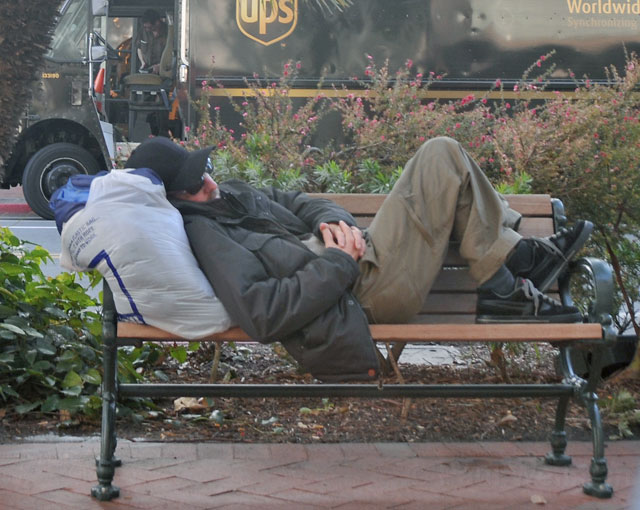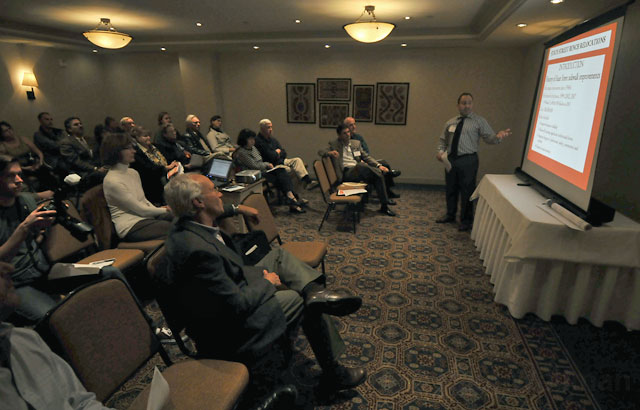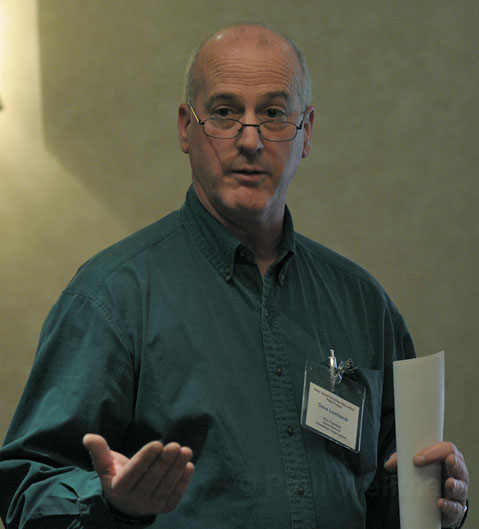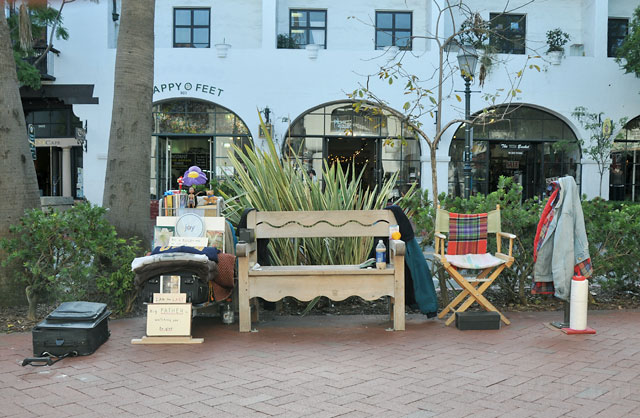Musical Benches
Citing Aggressive Panhandling and Camping, City Shells Out $50,000 to Move State Street Seats

Small changes can sometimes make big impacts, and it’s the city’s hope that subtly reorienting downtown benches will significantly cut back on aggressive panhandling and the tendency of homeless people to turn public seats into camp zones.
During a presentation Wednesday evening at the Canary Hotel, members of the Downtown Organization and Santa Barbara’s Redevelopment Agency unveiled a pilot project in which 14 benches on State Street’s 800 and 900 blocks will be swapped with nearby trash cans, newspaper dispensers, and bike posts, and then rejiggered perpendicular to the sidewalk instead of parallel to it.

The Redevelopment Agency, explained representative Marck Aguilar, provided $50,000 for the project, which includes design work and the labor of replacing brick, pouring new platforms, ubolting the benches, and tacking them back down. Construction is set to begin in April and finish in May — if and when the Historic Landmarks Commission signs off on the project in February — just in time for the summer tourist season.
Aguilar — stressing that there aren’t plans to completely remove any of the benches — said no changes had been made to the downtown seating since it was installed over a decade ago, but the city knew some kind of reworking was inevitable. The benches’ original purpose of allowing shoppers and those in restaurant lines to take it easy and enjoy State Street’s ambiance, said Aguilar, is too often bogarted by a crowd that annoys merchants and scares shoppers.
The thinking, he explained, is that people tend to linger longer when they have a nice sweeping view of the sidewalk, and they might be inclined to move on faster if that’s eliminated when benches are turned. Dave Lombardi, chairman of the Downtown Organization’s Safety Committee and owner of Fast Frames, noted that it would be uncomfortable for a person to sit sideways and hold a sign. “People are manipulating and monopolizing the benches,” Lombardi said, explaining his organization is always trying to balance the needs and desires of pedestrians and store owners.

If the relocation project is successful — Aguilar said he and his department will solicit feedback from the community on the plan’s effectiveness after it comes to life — the Redevelopment Agency will look at making similar changes to all State Street benches. The agency is also kicking around ideas of moving benches to face the street or removing their backs. They were originally designed to be only four feet long so people wouldn’t sleep on them, a strategy Aguilar admitted was only “mildly successful.” The concept of turning the benches into individual chairs was shot down because there simply isn’t enough money in the budget to make that happen, Aguilar explained.
Complaints of aggressive panhandling and general shenanigans on the part of the homeless people who use those two blocks of sidewalk rose dramatically around 2007 and have continued consistently since, said Lombardi. The stores hardest hit, he explained, are Cafe Zoma, Fiesta 5 Theatre, and the Apple Store — all on the 900 block of State Street, which recently became even more of a homeless magnet after Borders closed and left its front patio next to the public restrooms unused.
While managers at Fiesta 5 and the Apple Store wouldn’t comment on the matter, Cafe Zoma partner Krista Fritzen said she feels the cluster of seating near her shop and the theater attracts a crowd that is often “not family friendly” and creates “a circus of inappropriate behavior.” Never one to turn away a customer simply because of his or her living situation, Fritzen said she’s nevertheless fielded many complaints from customers unhappy with the scene just outside Zoma’s front doors. Fritzen also speculated that it may be the volume of benches — not their orientation — that’s contributing to the problem, noting the area has nine benches per block face (one side of the block between intersections) while there are only three benches per block face on the 400 and 500 blocks of State Street.

Wednesday’s meeting was attended by a number of city councilmembers including Frank Hotchkiss, who worried aloud if facing two benches toward each other would create an even more inviting area for the homeless. “Now they have a perfect little campsite,” he predicted, suggesting a pole be placed between the benches so “they can’t wheel in a cart.” Aguilar said that might be a possibility, but it could violate Americans with Disability Act codes.
Councilmember Randy Rowse — vice president of the Downtown Organization — said the plan was the “best and cheapest test,” calling it mild compared to Santa Monica’s “draconian strategies” to deal with its homeless population. Sharon Byrne, executive director of the Milpas Community Association, noted that Santa Monica has a “much more determined stance of getting rid of homeless.”
John Dixon, owner of Tri-County Produce, who, like Byrne, has been outspoken in his criticism of Santa Barbara’s transient population, asked Aguilar how many people currently use the benches for undesirable purposes, and how often the benches are occupied by them. He also wondered what exactly would be the measure of success. Aguilar said it wouldn’t be “feasible or economical” to use staff time to gather such specific pieces of data, explaining he relies on anecdotal information from store owners and shoppers to gauge progress.
Contending that there is “very little aggressive panhandling in Santa Barbara,” advocate for the homeless Dr. Lynne Jahnke said there is indeed panhandling, but those who engage in it are “poor and desperate.” They have the First Amendment right to do so, she went on. Jahnke relayed that she wasn’t able to attend Wednesday’s meeting because she was babysitting the dog of a homeless woman recently admitted to the hospital.
Police spokesperson Lt. Paul McCaffrey said his department has issued very few aggressive panhandling tickets since the ordinance went into effect in 2009. A lot of people wrongfully think panhandling is a crime, said McCaffrey, explaining it’s an act protected by free speech laws.



